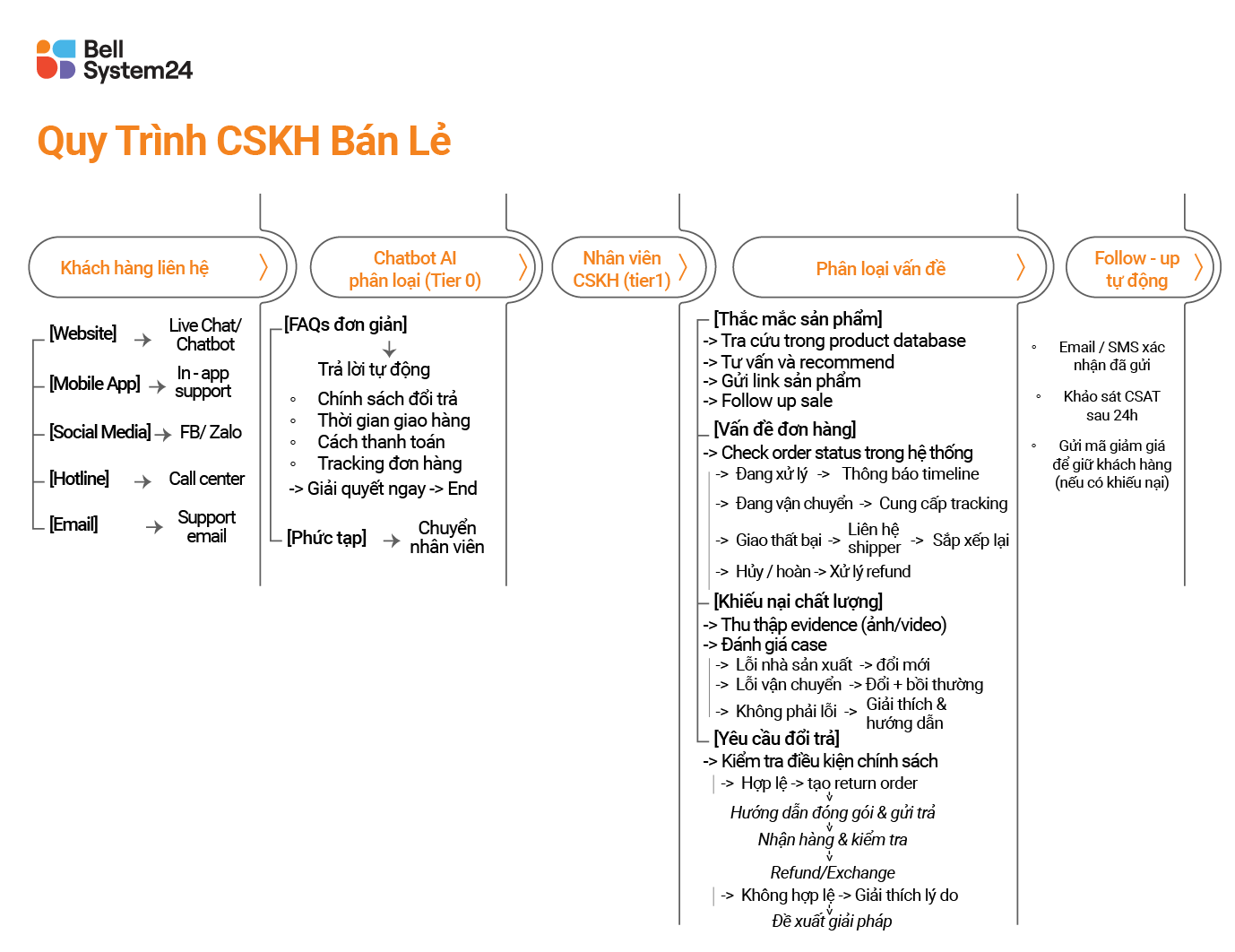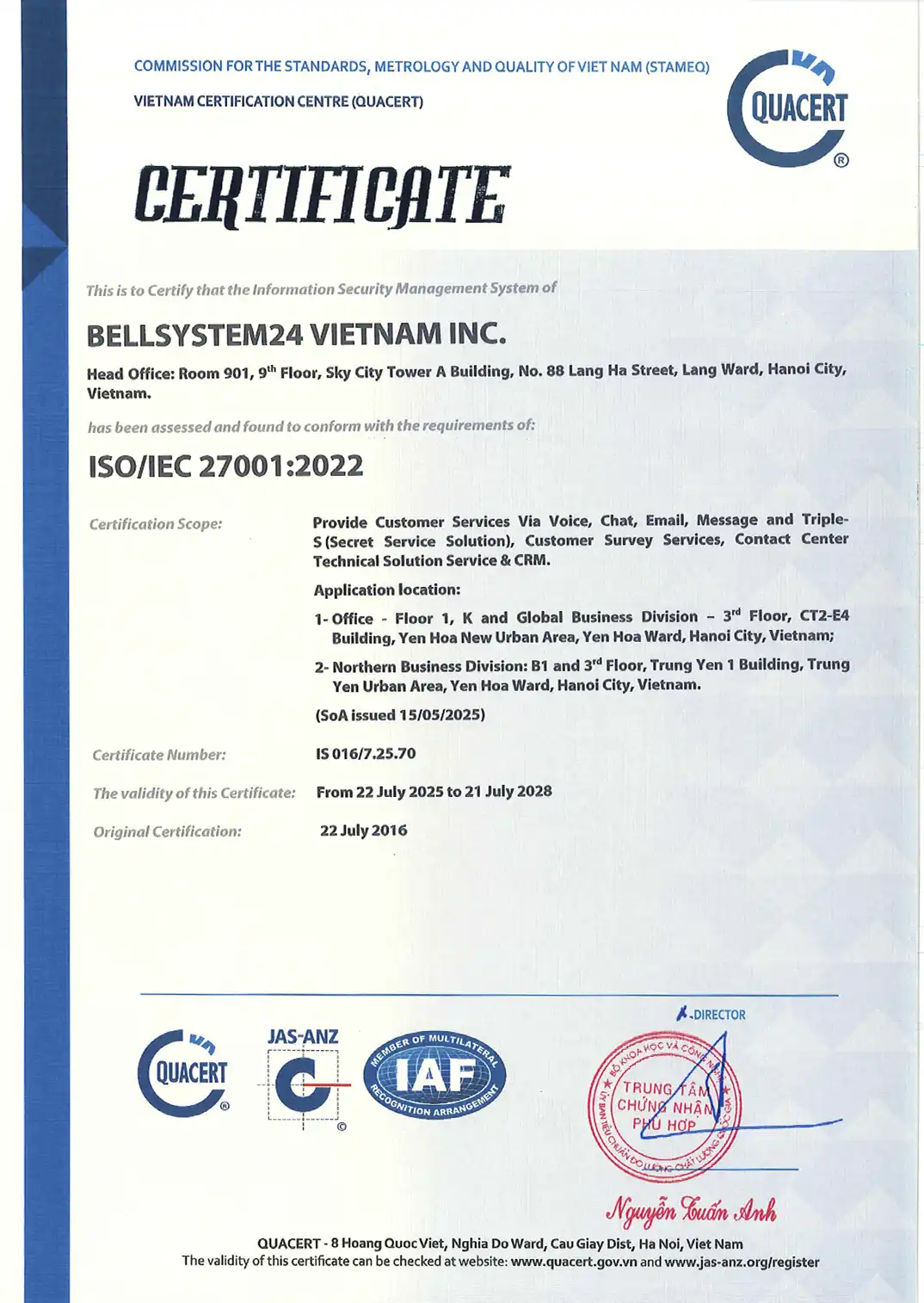Digital transformation and the challenge of customer care
In the era of digital transformation, customer behavior and expectations are changing dramatically, posing an urgent challenge for businesses to improve service quality. According to a report from McKinsey, 72% of customers want 24/7 support through various channels such as phone, email, online chat, and social media. This aligns with the growing trend of Internet usage, with over 4.6 billion people, representing 58% of the global population, connected to the Internet in 2023 (Statista). The prevalence of smart devices and easy access has led to higher customer expectations for interaction and support from businesses.
Challenges in meeting customer expectations
The pressure doesn't just stop at providing continuous service; it also requires businesses to ensure the speed and quality of support. A 2022 study by HubSpot found that 90% of customers expect a response within 10 minutes when they submit a request through an online channel. However, the reality is quite different: according to Zendesk, 53% of global customers feel disappointed because they have to wait too long for support. This not only diminishes the user experience but also threatens customer loyalty. Statistics show that 73% of customers are willing to abandon a brand if they don't receive prompt support, and only 1 in 26 dissatisfied customers will complain; the rest will quietly leave (CX Insights).
Thus, customer care is no longer an option, but has become a vital factor in the development strategy of businesses in the digital age.
To optimize costs, it is necessary to outsource the call center.
Operating an in-house customer service team often comes with significant costs, from recruitment and training to infrastructure. According to Deloitte, these operating costs can be 30-40% higher than outsourcing to a call center service provider.
Accordingly, businesses should consider outsourcing their call centers. Not only does this save costs, but using outsourced call center services also allows businesses to focus on their core values, such as product development and improving customer experience. Businesses can easily scale their customer service operations up or down without disrupting business operations. This provides flexibility and efficiency in resource management.
When a business should choose to outsource
Here are some situations when businesses should seriously consider outsourcing their call center:
- When call volume spikes: During holidays, promotional events, or new product launches, the number of customer inquiries often increases by 2-3 times. Internal businesses find it difficult to respond quickly.
- When lacking professional resources: Not every business has sufficient resources to train a professional customer service team, especially when technical and communication requirements are increasingly high.
- When expanding into new markets: When a business enters a new international or regional market, it needs a team that provides local language and cultural support.
- When you need to focus on core activities: Businesses focus their resources on strategic activities such as product development, marketing, etc.
At this time, outsourcing call centers is an effective solution to ensure that businesses are not interrupted in providing services, while also increasing customer satisfaction.
Trends in the development of outsourced call centers in the digital age
In the digital age, outsourced call centers are gradually changing with the support of modern technology:
Artificial Intelligence and Automation
Customer service centers utilize artificial intelligence (AI) to automate simple tasks, helping to reduce customer wait times. According to Gartner, by 2025, 75% of customer service centers will integrate AI.

Outsourced digital call centers are also reshaping how customers interact with businesses. Gartner predicts that by 2024, 85% of customer interactions will occur through digital channels such as chatbots, email, mobile apps, and social media. This emphasizes the role of AI in supporting omni-channel experiences, ensuring customers receive quick and accurate responses regardless of the platform they use.
In particular, AI chatbots such as ChatGPT and similar platforms have become important tools in personalizing customer service. Modern chatbots not only answer basic questions but also have the ability to analyze context, understand user intent, and assist with complex requests. For example, chatbots can help customers return items, update account information, or even handle complaints without human intervention.
Additionally, AI supports forecasting customer demand through historical data analysis. According to McKinsey, businesses using AI to analyze customer behavior can increase satisfaction levels by up to 251% and reduce customer churn by up to 401%. This creates a distinct competitive advantage in an increasingly fierce business environment.
Not only does it improve the customer experience, AI and automation also play a crucial role in reducing operating costs. According to IBM, businesses that implement chatbots can reduce customer service costs by up to 30% by reducing employee workload and optimizing processes. This is particularly useful during peak periods when call and request volumes surge.
However, to maximize the benefits of AI, businesses need to ensure that automation solutions are designed to complement, rather than completely replace, human support. The balance between technology and personal interaction will determine a business's success in enhancing the customer experience.
Read more: Can Artificial Intelligence (AI) Replace Agents in Contact Centers?
Data analysis
Outsourced call center businesses not only receive customer support services but also detailed reports on user behavior, enabling them to develop more effective business strategies.
One of the key factors is leveraging data to personalize the customer experience. A report from McKinsey indicates that companies using advanced data analytics to personalize services can increase revenue by up to 10-15%. For example, applying artificial intelligence (AI) to analyze purchasing behavior helps businesses better understand the needs of each customer, thereby providing appropriate products or services.
Additionally, integrating customer relationship management (CRM) systems with cloud technology has helped businesses optimize their customer care processes. CRM systems not only store customer information but also automate tasks such as sending reminder emails, managing complaints, or tracking feedback. This not only improves work performance but also increases customer satisfaction by 20-40%, according to Harvard Business Review.

Multilingual services
With the trend of globalization, many businesses require customer support in international markets. Call centers must now meet the demand for multilingual communication.
Customers in different markets not only need support in their native language but also expect an understanding of their culture, customs, and local factors. This requires call center staff to not only be fluent in the language but also possess refined communication skills appropriate to the cultural context of each region. According to a survey by CSA Research, 74% consumers tend to purchase from businesses that provide support in their language.
To meet this demand, many call centers have implemented strategies such as hiring local staff or training existing employees to improve their language skills. At the same time, modern technologies such as real-time AI translation are also being integrated to support immediate communication. For example, tools like Google Translate API or Microsoft Translator allow customer service representatives to quickly handle requests in languages they are not fluent in.
Additionally, implementing multilingual services helps businesses significantly improve customer experience, build trust, and expand market share. According to Common Sense Advisory, businesses that provide multilingual customer service can increase revenue by up to 301% in new markets.
However, managing multilingual services also poses many challenges. The costs of training staff, hiring language specialists, and investing in supporting technology are significant investments that not every business can afford to make immediately. In addition, ensuring consistency and service quality across multiple languages is also a difficult task, especially for rapidly growing businesses.
In summary, multilingual services are not only essential but also a competitive advantage in the era of globalization. Investing in this model not only helps businesses win over international customers but also builds a professional, reliable brand image globally.
Case study on outsourcing call centers in the digital age
Case Study 1: Airbnb

Background
Airbnb, the world's largest online booking platform, has experienced explosive growth over the past decade. With millions of users in over 220 countries and more than 40 languages, maintaining high-quality customer service has become a major challenge, especially when handling thousands of requests every day from both hosts and guests.
The Challenges of Airbnb
- Multilingual and multi-channel: Airbnb needs to support customers in multiple languages and through various channels such as email, chat, and phone.
- Rapid increase in request volume: During peak periods (holidays, major events), the number of requests increases significantly, overwhelming the internal system.
- Ensure a consistent experience: Even when outsourcing, Airbnb still needs to maintain service quality and consistency globally.
Solution
Airbnb has decided to outsource part of its customer service by partnering with call center providers in various regions around the world. They implement digital solutions to improve efficiency:
- Integrating AI technology:
Airbnb uses smart chatbots to handle basic requests (rescheduling, checking booking information). AI also supports call center staff by suggesting quick answers and solutions based on customer history. - Consistent global employee training
Airbnb requires its partners to outsource employee training according to its standards. All employees are trained in Airbnb's culture, ensuring consistency in communication style and problem-solving. - Using cloud technology
Airbnb implements a cloud-based CRM system, allowing all employees (internal and outsourced) to access customer data in real time, helping to increase problem-solving efficiency.
Results:
- Improve response speed: Problem resolution time has been reduced to under 5 minutes for basic requests.
- Cost savings: Outsourcing helps Airbnb save 30% in operating costs, especially during peak periods.
- Enhancing the customer experience: Airbnb recorded a 20% increase in customer satisfaction, particularly in international markets.
Case Study 2: Amazon

Background
Amazon, the world's largest online retailer, processes millions of transactions daily with customers from over 100 countries. At this scale, ensuring high-quality customer service becomes a huge challenge, especially when handling issues related to orders, refunds, and technical support.
Challenge
- Huge volume of requests: During peak seasons such as Black Friday or Prime Day, the number of calls and requests spikes, far exceeding internal processing capacity.
- Multilingual requirements: Amazon must support customers in regions such as Europe, Asia, and South America, where languages and time zones differ.
- Consistency: Amazon must ensure that all customer interactions with customer service are prompt, accurate, and consistent with the brand.
Solution:
Amazon uses an outsourced call center strategy combined with automation to optimize its services:
- Global Call Center Distribution:
Amazon partners with outsourced call centers in many countries such as India, the Philippines, and Poland to handle regional requests. This helps leverage the advantages of local languages and lower costs. - Deploying AI and Chatbots:
Amazon is investing heavily in AI, particularly through its chatbot platform to handle basic requests such as checking order status, return policies, and product usage instructions. Amazon's chatbot can handle up to 50% requests, significantly reducing pressure on employees. - Integrate cloud-based CRM systems:
Amazon uses an integrated cloud-based CRM system to provide outsourced employees with all necessary data on transaction history, preferences, and customer information. This helps resolve complex issues more quickly. - Training according to our own standards
Amazon requires its call center partners to train employees according to its own standards, including communication style and problem-solving procedures. Outsourced teams are also closely monitored to ensure service quality.
Results:
- Improve response speed: 80% requests must be resolved within 2 minutes via chatbot or outsourced staff.
- Cost savings: Outsourcing helps Amazon reduce operating costs by up to 40%, especially in areas with high labor costs.
- More effective international customer support: Multilingual services help Amazon improve customer satisfaction worldwide.
Thus, digital transformation has been changing the way businesses operate, especially in the field of customer care. Choosing an outsourced call center solution not only helps businesses optimize costs but also provides flexibility, ensuring superior customer service, even during peak periods. Leading companies such as Airbnb and Amazon have demonstrated that applying modern technology combined with effective outsourcing strategies can enhance customer experience while increasing global competitive advantage.
If you are looking for a trusted partner in the call center industry, let Bellsystem24 Vietnam accompany your business. With a professional team, advanced technology, and multilingual customer service, we are ready to help you build an excellent customer experience and optimize your resources. Contact us today for a consultation on the right solution!
Hotline: 1900 1739Email: contact@bell24vietnam.vn







